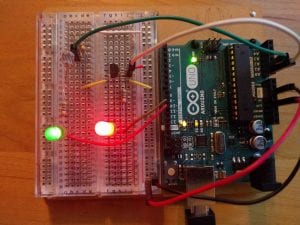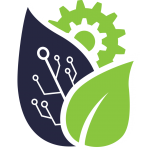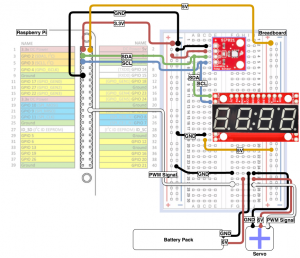Embedded Systems
Remote Monitoring and Control Systems
Overview
This module details the process of designing and implementing a system that can monitor and control environmental conditions. It provides the foundation for intelligently automating tasks that would be needed in a greenhouse weather station such as humidity & temperature control, a theme that will be continued throughout this suite of modules. In this introductory session, participants will program a microcontroller to interface with sensors and collect data. By the end of the module, students are trained in utilizing a simple embedded system that can be used in both long and short-term projects.
About the Module
This module is available as an independent study or as for credit as CRSN 151C .
The lab manual is available for viewing and download to the right; in it you will find the details of each day with instructions and important terminology, as well as the equipment list with links for purchase if you would like to attempt these tutorials at home. Each workshop has its own prelab that must be completed before attending the relevant session. You'll be directed to online content and resources designed to give a basic understanding of what you'll be working on for that day, such as circuit simulation tools or an illustration of the different networking protocols. A key component of the prelabs is the use of a lab notebook. Make sure to bring the notebook with any questions you may have on the relevant prelab content to each session; it is important that you understand these concepts. Each day of the module will cover a different topic and will contain a postlab that must be completed on your own time before attending the next session.
Learning Outcomes
By the end of this module, students will have demonstrated familiarity and ability in:
- Good laboratory Environment, Health and Safety practice
- Appropriate selection and use of a microcontroller board or single board computer
- Introduction to programming: Basic control structures, Types, and Boolean Operators
- Arduino IDE programming environments
- Analysis, design and testing of circuits
- Appropriate selection of electronic components and the use of data sheets
- Application of tools for project management (engineering notebook)
The example use-case used throughout this Remote Monitoring and Control Systems suite of modules is a connected greenhouse or weather station. By the end of these workshops, you will have the foundational understanding needed to select sensing components and program the microcontroller to create an automated temperature and lighting indicator circuit that collects and stores weather data.
Workshop 1: Introduction to IoT Hardware and Software

- Learn and Review
-
-
-
-
- Introductory programming
- Basic electronic circuitry design and build
- Arduino Low Power Library
- Local data storage
-
-
-
-
- Labs: Build, test, and calibrate an automated temperature and light sensing system to perform indicator tasks.
This session assumes little to no previous experience, and can be skipped by demonstrating the circuit to S-lab staff. We recommend following up this workshop with Introduction to Networking Infrastructure in order to complete your automated greenhouse weather station!
Location
The module will take place in the S-Lab's main facility in the Thimann Labs room 368. Please sign in with the lab manager upon arrival.
Workshops are grouped into sessions which are available for sign up to the right. You may not sign up for individual sessions or split between different groups. Plan to attend all workshops in your session.
Before attending your workshop, please review the manual and complete the online training. You are required to complete the EH&S Lab Safety Fundamentals and the EH&S Electrical Safety in Research courses through the UC Learning website before beginning any work in the lab.
Note: if you would like to use your own computer for this workshop, you must complete the "Set up" section in the lab manual before attending the first session.
Resources
- "Towards a definition of the Internet of Things" is an interesting white paper put out by the IEEE for further reading.
- GitHub is a convenient way to version and distribute your code on a social platform. Check it out here.


